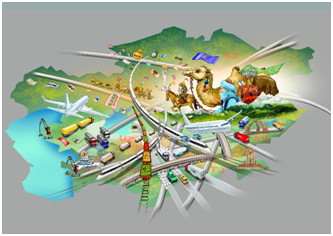Elvira Kadyrova

The name of the Central Asian region in the context of connectivity in Eurasia speaks for itself. The pace and better operationalization of trade and economic ties between Asia and Europe depend on the quality of transport links between the five Central Asian nations. And, ultimately, the connection of Central Asia with the East and the West will be one of the determining factors in success of major Eurasian initiatives, such as the Chinese initiative of the Belt and Road, the EU-Asia connectivity strategy.
Media round-up tell us about events and developments unfold today in the transport and communication life of the Central Asia.
***
A record 19 million tonnes of transit cargo was transported via Kazakhstan in 2018, reports Kazakh-TV.
Major land routes linking the largest markets of the EU and China traverse Kazakhstani steppe. One of them is north route, which spans Russia, Belarus and Europe, and the second one stretches via the Caspian Sea, Azerbaijan, Georgia, and the Black sea.
Although the most goods from China are still sailing in the oceans and voyage takes 40-45 days, the land route through Kazakhstan reduces the shipment time threefold.
Zeynolla Akhmetzhanova, head of transit and transport logistics development at the Kazakh Ministry of Investments and Development said the development of logistics and transport infrastructure is in full swing in the country.
Thus, the total capacity of all Kazakhstan’s ports reached 26 million tonnes per year. More than 1 trillion tenge of capital investments (US $ 2.6 billion) has been allocated for the construction and reconstruction of highways.
In total, more than two dozen road projects are being realized in the country.
Six main international transit corridors pass through the territory of Kazakhstan. Three of them have been fully put into operation and the work continues on other three corridors, said YerzhanTeleukhan from the Highways Committee.
In 2020, we are planning to launch traffic on all international transit routes, he added.
***
Recently, the construction of the Ashgabat-Turkmenabat highway, worth over US $ 2.3 billion, has started in Turkmenistan.
600-kilometer long autobahn, which is being built by local companies, promises maximum comfort and safety of traffic. The payment terminals, dozens of large and small bridges, underground passages, piped road interchanges with access to settlements, service centers, video surveillance systems, emergency communication points, weather warning system, control system for commercial transport (special altimeters, automated axle load meters, etc.) will be built and installed along the highway.
The expressway is to be commissioned by December 2023. There is hope that the super highway will encourage foreign trade flows. Obviously, the expectations will come true.
The attractive multimodal transport corridor occur to mind, probably, involving upgraded Turkmenbashi port on the Caspian shores – Ashgabat-Turkmenabat autobahn with onward access to Uzbekistan through Farap-Alat and Gazojak-Friendship border crossings.
By the way, according to the rules of transit traffic through Uzbekistan approved in December 2018, the Uzbek authorities have opened additional transit routes starting from mentioned entrances of the Turkmen-Uzbek border.
***
In 2019, cargo traffic on the China-Kazakhstan-Turkmenistan-Iran route will tend to further growth.
Iran intends to intensify container service. “Now we are planning to increase the volume of trade through this route. This year alone it is planned to bring 50 thousand tons of cargo from China. Negotiations were also held with Kazakhstan and Turkmenistan”, said the head of the delegation of Iranian Railways Ahmadiy Babak during the meeting with his counterparts from the joint-stock company “Uzbekistan Temir Yullari” (Uzbek Railways) in Tashkent.
Iranian and Uzbek railway operatorsmulled over proposals for the import of petroleum products from Iran to Uzbekistan and export of Uzbek sulfur backwards.
***
Flydubai is going to expand its map of destinations in Central Asia and will be the first UAE airline to establish flights to the capital of Uzbekistan.
Boeing 737 MAX 8 aircraft with a bright orange and blue logo of the Emirati air carrier will begin to perform Dubai-Tashkent flight five times a week from 11 March.
From 31 May, flights will be operated on a daily basis.
With the launch of five flights a week to Tashkent, flydubai will offer 33 weekly flights to seven points in Central Asia. Others include Ashgabat, Astana, Almaty, Shymkent, Bishkek, and Dushanbe.
***
In addition to the internal infrastructure efforts undertaken in the transport sector by the Central Asian countries, the development partners of the region play a great role in promoting the concept of interconnectivity.
Last week, the Asian Development Bank (ADB) has approved a $2 million regional technical assistance grant to support the development of railways in Central Asia Regional Economic Cooperation (CAREC) countries.
“This grant will support the study and development of a regional rail system that is quick, efficient, accessible for customers, and easy to use throughout the region”, said ADB Senior Transport Specialist Jurgen Sluijter.
The technical assistance will develop a regional rail traffic model. It will also help identify and prepare priority bankable investment projects and train staff of railway agencies.
The regional railway system will enhance access to regional and international markets and help to increase economic growth and social welfare.
CAREC countries – Afghanistan, Azerbaijan, China, Georgia, Kazakhstan, Kyrgyzstan, Mongolia, Pakistan, Tajikistan, Turkmenistan, and Uzbekistan – adopted a railway strategy up to 2030 to guide long-term railway development. /// nCa, 30 January 2019